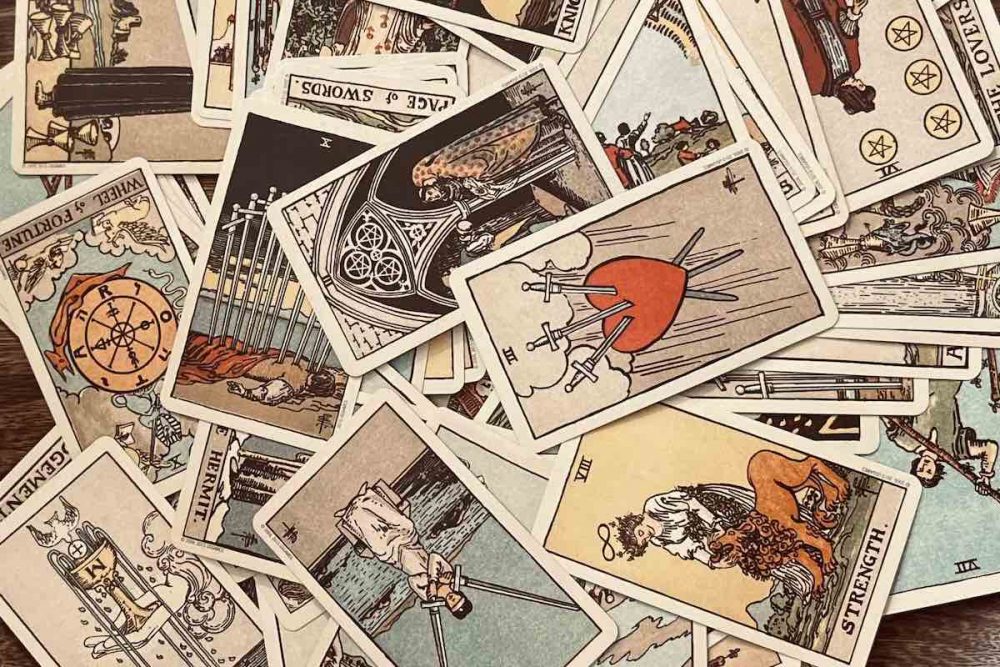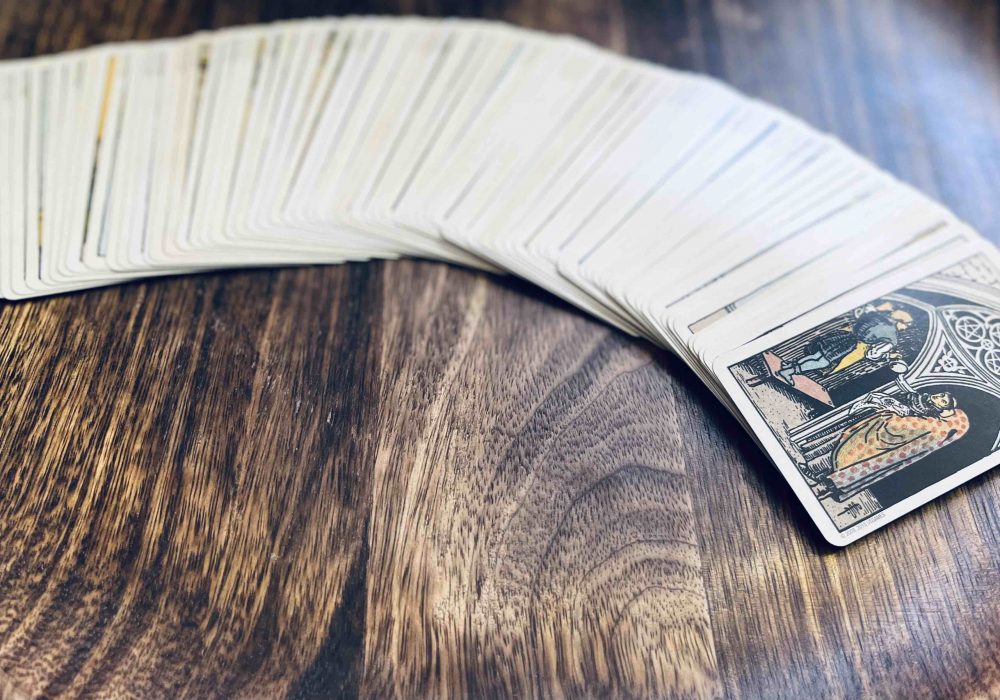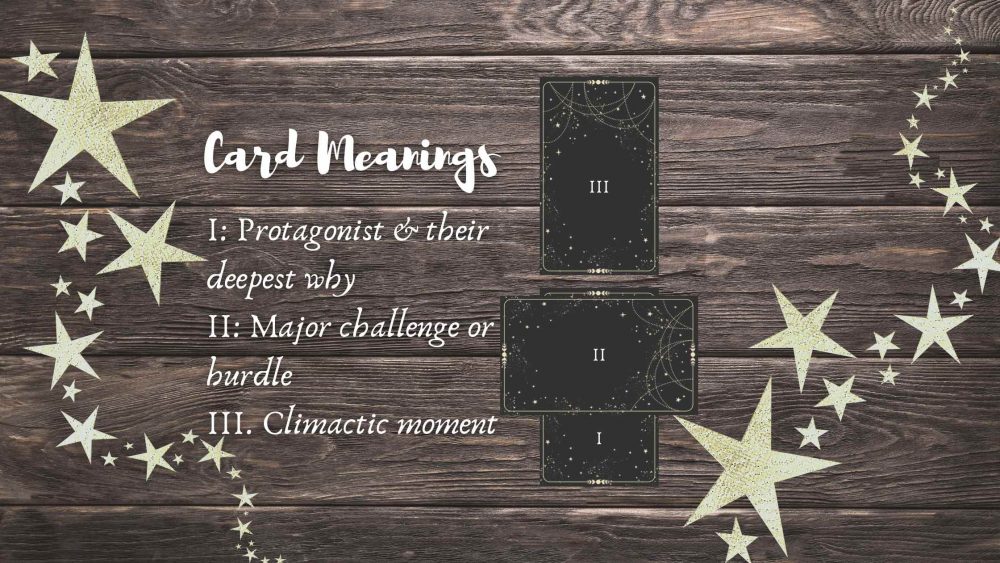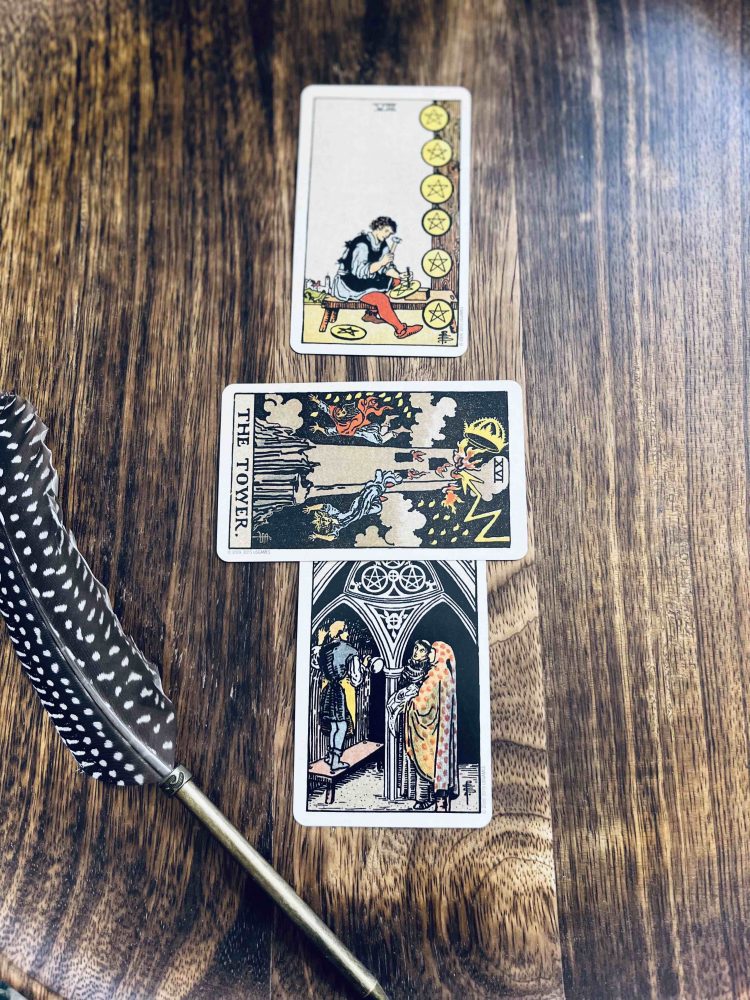
Today’s post is by author and book coach Margaret McNellis (@magickalbard).
I’ve always been obsessed with story, whether it was my five-year-old self asking my parents to read Winnie Pooh and the Blustery Day until they had it memorized (sorry not sorry!) or pursuing a bachelor’s degree in art history to study the tales told through the visual arts.
But it wasn’t until I began devoting more time to story that I realized all the ways tarot can help us tell stories.
Using tarot for writing is nothing new. There are many books on the subject, and with spirituality becoming more front and center via social media, magazines, books, TV series, and more, is it surprising that using tarot for story might undergo a bit of a revival?
As a tarot practitioner, one of the most common questions I’m asked isn’t, “What does my future hold?” but how people can learn to use their own decks. We’re all seeking answers, and the cards are ready to provide—if not to life, then to the tales we strive to tell.
I created a 9-card spread that weaves together character and story arc and allows me to use the imagery and symbolism in the tarot to understand story in another way, a visual way.
The art historian in me loves this.
While the 9-card spread is much too large to share in an article, you can work with a condensed version that focuses on helping deliver clarity on the most important foundational elements of storytelling: character and story arcs, or the internal and external journeys.
So grab your cards, and get ready to use them to spotlight the heart of your tale.
How do you interpret the cards?
If you’re new to working with the tarot, it can feel intimidating. At 78 cards, the tarot deck can seem both full of possibility and confusion. Plus a card’s meaning can shift based on what cards it sits next to, whether it’s reversed (some practitioners even read them sideways), or where it lands in a spread. After early attempts, you might be ready to pack your deck away in the farthest reaches of your cobweb-iest closet.
Please don’t. You can work with the cards even if you haven’t memorized them, and even if you’ve lost the little booklet that comes with most decks.
All you really need to do is follow your intuition. You can’t really get cards “wrong” because the message they give you is the message you need to receive. Yes, there exist preconceived ideas of what they symbolize, but the only reference you really need is your intuition. What does the imagery make you think of? The words? The number on the card, if it has one?
This is the key to reading intuitively, which is the type of tarot reading I practice.
I’m going to talk you through some tarot basics that I use, so you can start playing with them and seeing your story in a new light today.
The deck is split into 5 suits:
- The Major Arcana
- Wands
- Swords
- Cups
- Pentacles
The Minor Arcana
First, let’s talk about the minor arcana, numbers, and court cards.
- Wands: The suit of fire. This is a masculine-energy suit, so it’s direct and focused. This suit often has to do with business, family, and home. It’s associated with zodiac signs like Aries, Leo, and Sagittarius.
- Swords: The suit of air. This is the other masculine-energy suit, so it’s also active and focused. This suit often has to do with intellect, ideas, legal matters, education. It’s associated with zodiac signs like Gemini, Libra, and Aquarius.
- Cups: The suit of water. This is a feminine-energy suit, so it’s more reactive and big picture. This suit often has to do with emotions, interpersonal relationships, and spirituality. It’s associated with zodiac signs like Cancer, Scorpio, and Pisces.
- Pentacles: The suit of earth. This is the other feminine-energy suit, so it’s more reactive and big picture. This suit often has to do with resources, which can but doesn’t always include wealth. It can also relate to craftsmanship. It’s associated with zodiac signs like Taurus, Virgo, and Capricorn.
Within each of these suits, you’ll find numbered cards and court cards. The numbered cards, depending on the deck, may have scenes or just pips to represent the numbers.
Court cards reference the seeker or someone else in their lives. Pages and Queens often carry feminine energy, whereas Knights and Kings often carry masculine energy. Pages are often young, inquisitive, adventurous, and sometimes naïve. If they were readers, they’d be young adult readers. Knights are your New Adult readers—they’re older than Pages, but not possessing the wisdom of age that Queens and Kings have. In tarot, Queens rule with the heart, and Kings rule with the mind.
Numbers matter, too. For this, here’s a brief numerological reference list you can use to help you understand the minor arcana. By combining these numbers with the suit, you can gain a deeper understanding of each numbered card in any of these four suits:
- Aces represent new opportunities, leadership, and gifts from the Universe.
- Twos are all about balance and partnership.
- Threes are about community and creativity.
- Fours reflect stability and foundations.
- Fives show challenges and change.
- Sixes involve caring for the self or others in one’s sphere.
- Sevens are about retreating into the self and reflection.
- Eights talk about hard work and mastery.
- Nines suggest near completion and/or serving others in a larger sphere.
- Tens are about the end of one cycle and the start of another.
The last key thing to understand about the minor arcana suits is they refer to everyday life.
The Major Arcana
The Major Arcana refers to the soul’s journey through life. These are bigger, more life-changing moments. A tarot spread with a lot of Major Arcana cards for a character rarely points to a quieter story.
Here’s a quick guide to help you understand how to read the Major Arcana:
- The Fool is like the grand page. This card is all about faith in the self and the Universe, but also sometimes naivety.
- The Magician and The High Priestess are about the ability to manifest desires and know things intuitively, respectfully. They are the masculine and feminine energy cards.
- The Empress and The Emperor speak of the ability to create/fertility of ideas and the ability to rule, respectively. They are like the grand queen and the grand king. We can also think of them as expansive (Empress) and restrictive (Emperor) energies.
- The Hierophant is a card that represents authority or, if reversed, rebellion/standing out.
- We often see The Lovers as a romantic card—and it can certainly refer to romance. But really it’s about external partnership, whereas The Chariot is about internal partnership and control of one’s own masculine and feminine energies to create movement in life/the soul’s journey.
- Strength is that quiet courage, compassion and strength together.
- The Hermit is about self-reflection or being the light or wisdom for another.
- The Wheel of Fortune suggests change, but change that relies on chance. This could be a signal that the seeker can exert more control over their path or that they are trusting of the Universe.
- Justice is all about balance and decision.
- The Hanged Man shows that waiting, or perhaps a fresh perspective, would help the seeker.
- Death is a card that often scares people, but it doesn’t mean physical death. Rather, it’s an opportunity to rise from the ashes. Not that the “phoenix burning” moment won’t be challenging—it will be. But the seeker can grow and make something better of their situation.
- Temperance is about balance and moderation.
- The Devil is all about temptation and the seeker’s ability to break the proverbial chains.
- The Tower is about ideas that were built upon a foundation of inaccuracy or something that did not turn out to be true. It’s about disillusionment and the opportunity to create a narrative for the self based in truth and reality.
- The Star is about following one’s dreams and recognizing that to succeed, dreams must be grounded in real, temporal effort.
- The Moon is about illusion and magick.
- The Sun is about success and the ego.
- Judgment is about action and consequences.
- The World is about wisdom and completion of the cycle (which often restarts at The Fool).
A note about potentially frightening imagery: Depending on the deck you’re using, some cards may have alarming imagery. If you don’t have a deck yet and you’re worried about this, I recommend the Cat Tarot. It’s whimsical and light, but still useful. Remember: The tarot is symbolic. A collapsing tower doesn’t mean lightning will strike your house and cause it to crumble.
A note about the card meanings above: These are surface-level descriptions. As you get to know the cards more, they will take on deeper meanings. They may also take on more personal meanings. There are many books and online resources that can help you study the cards if you wish to expedite this process, but if you’re reading intuitively, don’t worry about it. Trust that the meaning you derive is the right one.
How to have a productive tarot reading
Now that you’re ready to work with the cards, I want to take a moment to ensure that you’ve got some practices in place that will help you make the most out of your reading.
The first is understanding spreads, or layouts. These are placements for the cards, chosen to help you not only read the cards in a specific order, but to see the story of the cards unfold spatially as well. If you’re new to using spreads, this will become clearer when I explain the 3-card spread below.
It doesn’t matter how you shuffle the cards. You can shuffle them any way that makes sense to you. Tarot cards can sometimes be large and some shuffling styles may feel unwieldy. Go with what works. We can say the same for cutting the deck.

It doesn’t matter how you deal or select the cards, so long as you’re consistent. Don’t flip some around and not flip others the same way.
Keep an open mind. If you are unwilling to trust the cards, they’re not likely to make sense. If you don’t believe in using them spiritually, that’s fine—think of them as a writing tool. Try not to judge the practice of using them—or your own practice of using them—ahead of time.
Finally, focus on your protagonist and story. If you don’t have one in mind yet, just focus on being ready to think about character development and story development, and trust that the cards will give you the results you require.
Get story clarity with this 3-card spread
Let’s start with the layout of the cards. The first one is easy; you’re going to place it on a flat surface in front of you in the portrait orientation. This card will represent your protagonist and their deepest desire—the why of their story.
We will place the second card in landscape orientation, atop the first card. This card is going to represent your protagonist’s major challenge or hurdle, or what stands in their way. It could be a situation or, with an antagonist, another character or group. This is going to help create tension in your story.
We will place the third and final card in portrait orientation, above the other two (not on top of them, just farther away than the first and second cards). This third card is about the climactic moment. This is the most significant reversal of your story, when the internal and external journeys shift simultaneously, when all the external beats have led up to this moment of highest tension when the reader finds out if your protagonist has changed or not, where the story tests whether your protagonist is dynamic or static.

Let’s consider a sample reading.
The first card is the Three of Pentacles. Maybe this character is an artist—a writer, a singer, an actor perhaps, dreaming of the recognition of others. But not just recognition—the type that proves the artist’s mastery of their craft. They may also dream of freedom from imposter syndrome.
The second card is The Tower. The hurdle is internal on one level, and external on another. Perhaps this artist has been told time after time that they won’t be successful. The Tower may be their first brush with success. Maybe this is the first time they’ve really had an attack of imposter syndrome. Maybe they’re ready to give up their craft.
The third card is the Eight of Pentacles. The climactic moment is when they can choose to prove that it’s through their hard work, not dreams alone, that they experience mastery. That it’s not always easy and sometimes they fail, but they can pick themselves up and get back to their creative work in order to succeed.
Sounds a lot like a budding novelist, doesn’t it?
This character’s deepest why is to have their work be appreciated, to be loved. Maybe they themselves create art in order to be loved. It doesn’t get any deeper than that.
Disillusionment creates the tension, the challenge of seeing past it to a more honest narrative.
The reversal, where the protagonist shows they can change and put real-world and working effort into their dreams, is the climactic moment of this story.

We’re given the internal journey in all three cards. The dreamer faces disillusionment and must reframe how they see themselves as successful. We’re also given the opportunity to dream up external beats. I gave some examples in the sample reading, but there are many situations that could prompt this sort of emotional journey.
Final thoughts
These three cards can help you gain clarity and focus on your story and the foundational elements that matter most. But there’s so much more tarot can do for your characters—and for you, as the writer. If you’re curious about how tarot can be a tool for writers, I hope you will continue to explore and trust your intuition.
I’m still learning about ways these cards can help with storytelling, both from a character and writer perspective, but have incorporated this practice into my writing and book coaching experiences. I’ve not only found it fulfilling and helpful, but also fun.
Fair warning though, I’ve become a bit of a tarot deck addict, and the same can easily happen to anyone. Thankfully, they don’t take up too much room on the shelf.
Margaret McNellis, MFA is an indie author, Author Accelerator Certified book coach, and witch/tarot practitioner. Her podcast, The Magickal Bard, helps listeners weave witchcraft and writing together for a magickal authorship journey. She loves helping writers boost their craft and confidence with integrity, creativity, empathy, & a dash of magick. Learn more at her website.

I’ve seen some other articles on using tarot this way – I quite like the straightforward approach you outline here (although I am curious about that 9-card spread!)
You may enjoy this piece, that I’ve carried with me since it was first published (I’m not the author).
https://druidjournal.net/2007/02/23/drawing-cards-storyboarding-the-tarot/
Thank you! I’m so glad it’s helpful. I share the 9-card spread in a variety of ways, from readings to a course to free webinars (my next for this spread is in July).
Thank you also for sharing that resource! It definitely looks like a good one; I will be sharing it with folks.
I love this, Margaret! I’ve been using Tarot for Writers by Corrine Kenner. The Tarot is quite overwhelming and can be confusing. It does take time to learn about this kind of path. It’s a great creative tool! I like your explanation and directions. Very helpful.
I love that book! The tarot can be overwhelming, but I believe that an intuitive approach does three main things for us:
I’m so delighted you found this article helpful! Thank you!
As a pro tarot reader and writer, I welcome any article using tarot in writing! I would love access to the original 9 card spread if that is available. I didn’t find it on Margaret’s site though. Can we find it anywhere?
Thank you, Sheila! I share the spread in a few ways–in a course, in readings I give myself, and in a free webinar I run every now and then. The next one is scheduled for July. The webinars are free. 🙂
Thanks, Margaret. I just found the right site.
Wonderful! Thank you!
I love this so much. Margaret read my tarot cards and it was such a great experience!!
Thank you! It was a pleasure.
I ran to my office to get my cards and figure out the end of my book. Such a fun way to spark ideas and creativity!!!
Yay! I hope the cards helped and that you have a target so you can write forward!
I’ve read Tarot for over 25 years and this is a wonderful explanation of the cards and an ingenious tool for writers! Thank you for sharing your knowledge and insight!
Thank you! I’m so glad you found it helpful.
I too am an addict 🙂 But probably do not have as many decks. I love this post too btw and thank you so much for taking the time to create it. Many blessings
Thank you! I’m so glad it helps! I ended up sharing the whole 9-card spread recently on my podcast, The Magickal Bard, if you want to go deeper!